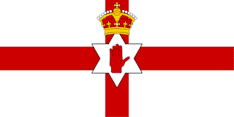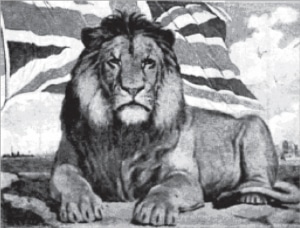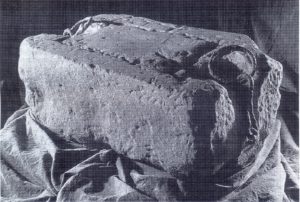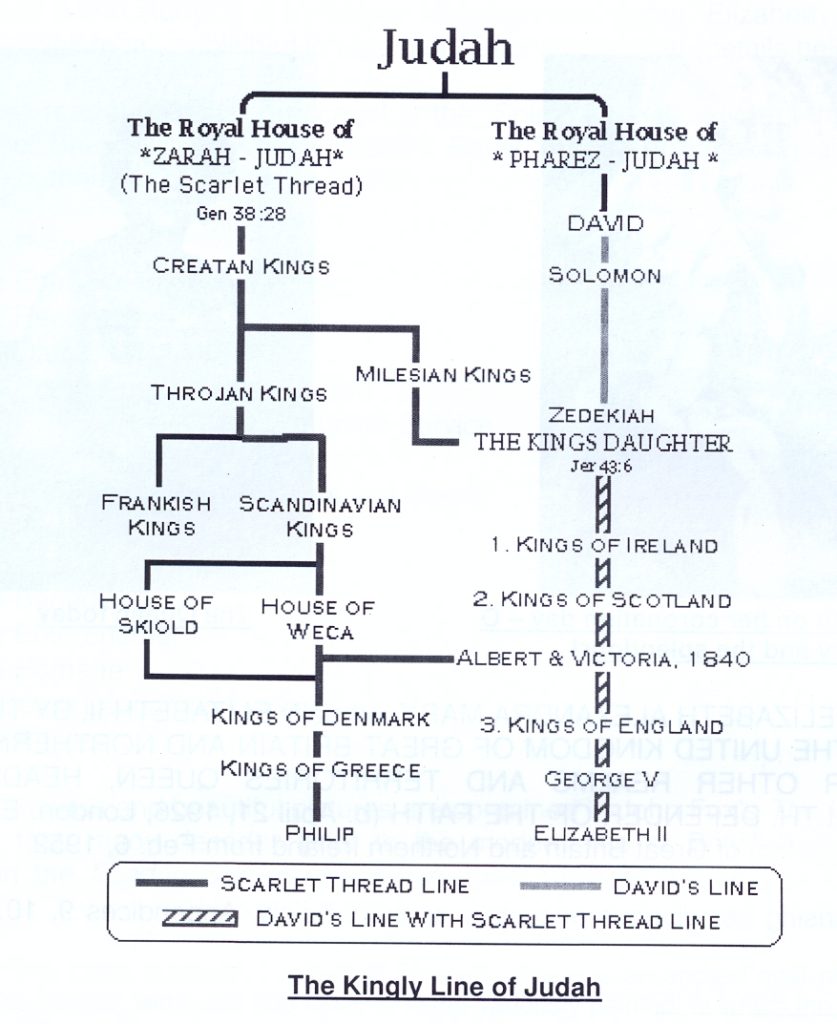THE TRUE ROOTS AND ORIGIN OF THE SCOTS – (4)
A research summary and pointers toward further research
“Wherever the pilgrim turns his feet, he finds Scotsmen in the forefront of civilization and letters. They are the premiers in every colony, professors in every university, teachers, editors, lawyers, engineers and merchants – everything, and always at the front.”- English writer Sir Walter Besant
“The mystery of Keltic thought has been the despair of generations of philosophers and aesthetes … He who approaches it must, I feel, not alone be of the ancient stock …but he must also have heard since childhood the deep and repeated call of ancestral voices urging him to the task of the exploration of the mysteries of his people …He is like a man with a chest of treasure who has lost the key”
(The Mysteries of Britain by L Spence)
“In his essay on Certain Monuments of Antiquity, Weaver says (p. 118):
“It appears that the Irish kings, from very ancient times until A.D. 513, were crowned upon a particular sacred stone called ‘Liath Fail’, ‘the Stone of Destiny’, that, so also, were the Scottish kings until the year 1296, when Edward I of England brought it here. And it is a curious fact that this stone has not only remained in England unto now, and is existing still under the coronation chair of our British sovereigns in Westminster Abbey, but that all our kings, from James I, have been crowned in that chair. This being a fact so curious, we shall quote its particulars in a note taken from Toland, in his History of the Druids (pp. 137-9).”
“Toland’s statement is this:
“The Fatal Stone (Liag Fail) so called, was the stone on which the supreme kings of Ireland used to be inaugurated, in time of heathenism on the hill of Tarah; it was superstitiously sent to confirm the Irish colony in the north of Great Britain, where it was continued as the coronation seat of the Scottish kings ever since Christianity; till in the year 1300 (1296 A.D.). Edward I, of England brought it from Scone, placing it under the coronation chair at Westminster, and there it still continues. I had almost forgot to tell you that it is now called by the vulgar, Jacob’s stone–as if this had been Jacob’s pillow at Bethel!”.
“Dean Stanley, one-time custodian of the Stone, in his book Memorials of Westminster Abbey, sums up its historical importance in these words; ‘It is the one primeval monument which binds together the whole Empire. The iron rings, the battered surface, the crack which has all but rent its solid mass asunder, bear witness of the English monarchy–an element of poetic, patriarchal, heathen times, which, like Araunah’s rocky threshing floor in the midst of the Temple of Solomon, carries back our thoughts to races and customs now almost extinct; a link which unites the Thwne of England to the traditions of Tara and lona’ (2nd Edit. pg. 66).
“In appearance the rugged surface of the Stone of Destiny is of a steely dull purplish color, varying somewhat, and with some reddish veins. It is composed of calcareous sandstone and imbedded in it are a few pebbles; one of quartz and two others of a dark material (porhyrite or andesite?). Its shape is roughly “pillow-like” being about 26″ in length; 16″ in. width, and 10 1/2″ in depth. Across its surface runs a crack and some chisel-marks are still visible on one or two sides. It appears to have been in the process of being prepared for building purposes, but was discarded before being finished. There are two large iron rings (of some rust resistant alloy), one at each end of the Stone which hang loosely from eyes, made of similar metal let into the Stone.
A description of the chisel-marks is, “The Stone has only one inscription, best described as a Latin cross, which gives no clue to the Stones heritage.”
“The rings in the ends of the Stone would indicate that porter poles were once used to transport the Stone. At first, it would appear as if two poles were used, one of them passed through the ring at each end, so that four persons would be required to carry it. However, when turned up, these rings protrude above the top of the stone, enabling one pole to be passed through both rings across the top of the Stone, theoretically allowing it to be carried by only two persons.
“In preparation for King George V’s coronation, the Stone was temporarily removed from the Coronation Chair, and a photograph was taken of it. This photograph disclosed that a groove runs right across the stone from ring to ring. From its appearance this groove was not cut, but was clearly the result of friction from a single pole being passed across from ring to ring. Such an indentation and wearing away of material indicates the enormous amount of carrying that the Stone was subjected to. If, as it appears, a single pole was used, because of the weight of the Stone (about 336 pounds) it is probable that more than two persons actually carried the Stone. Yoke-like cross beams could have been attached to both ends of the pole for the convenience of two or more persons at each end of the pole.
“British, Scotch and Irish records of the Stone of Destiny locate it at Tara, Ireland (some five centuries before Christ), from where it was transported to Scotland in circa A.D. 498 by Fergus the Great. From there it was taken to lona circa A.D. 563; then to Dunstaffnage from where it was removed to Scone, near Perth, Scotland. Finally it was moved, by Edward I, to Westminster Abbey, London in A.D. 1296. Thus, from Tara to Westminster, covering over 1800 years of history, it was never carried to any appreciable extent. The mere removal from these places could not account for the wearing away of the Stone that was evidently caused by the friction of a pole used in constant carrying. This must have been the result of many months of continuous carrying, prior to its arrival in Tara. The story of its journeying from Bethel, in the time of Jacob, and its accompanying the children of Israel in the Wilderness, would account for its present condition.
“One of the most significant facts about the Coronation Stone is that no similar rock formation exists in the British Isles. Professor Totten, the eminent professor of Science at Yale University, after making a thorough examination of the Stone made the following statement: “The analysis of the stone shows that there are absolutely no quarries in Scone or lona where-from a block so constituted could possibly have come, nor yet from Tara”. Professor Odlum, a geologist (and Professor of Theology at an Ontario University), also made microscopic examinations of the Coronation Stone, comparing it to similar stone from Scotland (including lona and the quarries of Ireland) and found them dissimilar.
“Professor Odlum became tremendously interested in the Stone. He was intrigued with the idea that perhaps its source could be found in Palestine, as suggested by the ancient records of Ireland. Determined to make the search, and after several weeks of unsuccessful exploration, Odlum discovered a stratum of sandstone near the Red Sea at Bethel, geologically the same as the Coronation Stone. Relating the circumstances of the discovery to a friend upon his return to Britain, the Professor stated:
“I put on my old mackintosh, I stuck my geologist’s hammer in my pocket, and I went out for one last look. It was pouring rain. I walked along the same places I had walked over and over again, looking for stone. Suddenly, while I was walking along a certain pathway, with a rocky cliff on either side, the sun shone on the rain-streaked piece of rock, and I noticed a peculiar sort of glitter that I thought I recognized. I climbed up, and I found that wet rock, as far as I could see with the magnifying glass I had, was of the identical texture I had been looking for.” I chipped off a piece from the living rock. I took it back to the hotel and examined it as well as I could. I was sure I had got what I wanted”.
“Although a microscopic test of the sample Bethel stone matched perfectly with the same test made of the Coronation Stone, the Professor wanted to make chemical tests of both stones. to dispel all doubts as to the source of Britain’s treasured relic. To save time, Odlum cabled a geologist friend in England and said:
“Will you do all you possibly can to get a piece of the Coronation Stone no bigger than a pea, in order that we may submit it to a chemical test.” The geologist friend made application to the Dean of Westminster Abbey to be allowed to take a piece, no bigger than a pea, from the Coronation Stone. The Dean said: “I daren’t let you have permission. The only way you can get permission would be from the Archbishop of Canterbury.”
“Application was made to the Archbishop of Canterbury, and this was the reply of the Archbishop: “To take a piece from that stone no bigger than a pea would require a special Act of Parliament to be passed by the House of Commons, endorsed by the House of Lords and signed by the King; and if, you get that,” said the Archbishop, “I won’t give you permission.”(32)
A recent work on the subject of the stone of scone notes:
“A song about the Stone was composed in England, probably shortly after the death of Edward I in 1307. In this it is stated that Scota, Pharaoh’s daughter, brought the stone directly from Egypt to Scotland, to a place close to Scone. Twenty years later William de Rishanger offered further elaboration when he wrote that [Scottish King] John Balliol sat on ‘the royal stone which Jacob placed under his head when he was going from Beersheba to Haran”‘(33)
Finally, one researcher presents us with further information:
“For some time I’d been wondering: why, if the Stone of Scone (Lia Fail, Stone of Destiny, whatever) really came from the high place where Jacob slept near Bethel, it is composed of sandstone and not limestone? Limestone is the rock out of which the hill country of central Israel and Judah is made. Sandstone is found much deeper in the ground (so deep that you have to get down toward the Jordan or the Dead Sea to find it, or further south in the Negev). Readers with retentive memories of various versions of =The US&BC In Prophecy= and other sources (like lectures by Raymond F. McNair) will recall that the Stone of Scone is made of “purple calcerous sandstone”, and that there have been reports of similar sandstone near the Dead Sea in the land of Moab. But why drag a 300-pound rock all the way from there to Bethel (then Luz)? Is there an outcropping of sandstone in the area that isn’t normally remarked on? Even Dr. David Livingston, archaeologist at the Associates for Biblical Research who has dug much in the area of Bethel, told me such an outcropping would be most unusual. He personally didn’t seem to know of any. Well, I’d like to cite for you an old letter (dated December 21, 1991) written to me by E. Raymond Capt on the subject, when I asked him about this very thing. I cite the letter exactly as I received it, spelling errors and all.
( …) There is several outcropping of sandstone among the limestones near Bethel. My authority is George Thompson of Glastonbury who also showed me the laboratory reports on tests they did on samples of the sandstone from Bethel and samples from England and Scotland. They also did microscopic photos of the samples of which I have copies. Their verdict- as near as I can remember what was written was – (When comparing them with samples taken directly from the Stone of Destiny by the mason in Scotland when dowels were installed between the two pieces of the stone before given back to England by the Scots) The sample (from Bethel) is closely related in time and space as that from the (Coronation Stone) The laboratory did not know what samples came from where- they were only numbered for them. ( . . .)”34
Is the Throne of David still with us today?
David was a man after God’s own heart (I Sam. 13:14). Because he was a man with a tender conscience toward his Creator, God made a separate and distinct covenant with him in addition to the one He had made with Israel. When David wanted to build a house for God, He sent a message to David through the prophet Nathan:
“When your days are fulfilled and you rest with your fathers, I will set up your seed after you, who will come from your body, and I will establish his kingdom. He shall build a house for My name and I will establish the throne of his kingdom forever. I will be his Father and he shall be My son. If he commits iniquity, I will chastise him with the rod of men and with the blows of the sons of men. But My mercy shall not depart from him, as I took it from Saul, whom I removed from before you. And your house and your kingdom shall be established forever before you. YOUR THRONE SHALL BE ESTABLISHED FOREVER” (2 Samuel 7:12-16) .
This promise is again repeated in Psalm 89:
“I have make a covenant with my chosen, I have sworn unto David my servant, Your seed [dynasty – Moffatt] will I establish for ever and build up your throne to all generations” (verses 3-4).
So far as the world knows the last king to sit on the throne of David was Zedekiah of Judah when the Babylonians conquered Judah and took them off captive to the land of Babylon about the year 586 BC. The throne of David was never restored when the Jews returned to the land of Palestine after their captivity.
God promised to David that his throne would last to all generations or FOREVER. If God has not failed to keep His word we need to look for David’s throne (incredibly described as the throne of the Eternal in I Chronicles 29:23) elsewhere than the land of Palestine where the Jewish state of Israel is today.
When Judah was taken by Babylon into captivity Nebuchadnezzar blinded Zedekiah and killed all his sons (Jer. 37:1-9) , seemingly destroying the royal dynasty. Former King Jeconiah (Jehoiachin) was at that time, in the dungeons of Babylon and he had sons to continue David’s line. It was through his line of descendants that Jesus Christ was born (Matt. 1:12-16). God decreed the following about Jeconiah:
“Thus saith the Lord, Write ye this man childless, a man that shall not prosper in his days: for no man of his seed shall prosper, SITTING UPON THE THRONE OF DAVID, AND RULING ANY MORE IN JUDAH“! (Jer. 22:30).
As far as the throne of David was concerned he was childless. God had determined that none of his children would ever occupy the throne. However, God’s commission to the prophet Jeremiah was to be:
“over the nations and over the kingdoms, to root out and to pull down, and to destroy and to throw down, to build, and to plant” (Jer. 1:10).
God would use him to help keep the royal line alive and plant it in another land. Nebuchadnezzar did not kill the King Zedekiah’s daughters who escaped with Jeremiah (Jer. 43:5-7, lsa. 37:32-33). It would be through one of the daughters of Zedekiah that God would keep the throne of David alive. What land did God lead them to? In Ezekiel 17 God says:
“I will also take of the highest branch of the high cedar, and will set it; I will crop it from the top of his young twigs a tender one [a daughter] and will plant it upon a high mountain [nation] and eminent. In the mountain of the height of Israel will I plant it and it shall bring forth boughs, and bear fruit” (verses 22-23).
God directed them to northwest Europe (lsa. 49:12) to where the House of Israel had migrated to.
One work well worth studying is Professor Megalommitis’ paper “Elizabeth II on the Throne of David and Solomon”, published in Origin of Nations magazine (details below).
You can also read a fascinating account of the “Spiritual Significance of the Coronation” in chapter 11 of Brian Williams’ book Britain‘s Royal Throne. Williams explains the following steps in the coronation ceremony in detail:
- The Preparation
- The Entrance into the Church
- The Recognition
- The Oath
- The Presenting of the Holy Bible
- The Beginning of the Communion Service
- The Anointing
- The Presentation of the Spurs and Sword
- The Investiture
- The Putting on of the Crown
- The Benediction
- The Enthronement
- The Homage
- Te Deum Laudamus hymn
- The Recess
Further information and beautiful pictures are contained in John Fox’s The World‘s Greatest Throne. In fact, many decades prior to the modern rise of British-lsraelism, an article appeared in the London Times newspaper in June 1837, at the time of Queen Victoria’s coronation:
“This chair, commonly called St. Edward’s chair, is an ancient seat of solid hardwood, with back and sides of same variously painted, in which the Kings of Scotland were in former periods constantly crowned … Between the seat and this board is enclosed a stone, commonly called Jacob’s, or the fatal marble stone .. . History relates that it is the stone whereon the patriarch Jacob laid his head in the plains of Luz.”(35)
Although various royal lines are jealous of each other and in continuous contention, when Christ returns He shall take over the throne of David that God has continued to preserve since the days of His promise to King David (Luke 1:32, Gen. 49:10) and all contention will cease.
It is then that we shall find the final conclusion to the “Lord’s Throne” with the Messiah Himself claiming and sitting upon it in glory and authority. Under Him will reign the saints, Israel and the physical descendants of Judah, including those of royal blood.
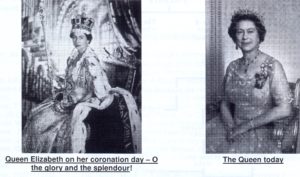 Officially she is ELIZABETH ALEXANDRA MARY, officially ELIZABETH II, BY THE GRACE OF GOD, OF THE UNITED KINGDOM OF GREAT BRITAIN AND NORTHERN IRELAND AND OF HER OTHER REALMS AND TERRITORIES QUEEN, HEAD OF THE COMMONWEALTH, DEFENDER OF THE FAITH (b. April 21, 1926, London, Eng.), queen of the United Kingdom of Great Britain and Northern Ireland from Feb. 6, 1952.
Officially she is ELIZABETH ALEXANDRA MARY, officially ELIZABETH II, BY THE GRACE OF GOD, OF THE UNITED KINGDOM OF GREAT BRITAIN AND NORTHERN IRELAND AND OF HER OTHER REALMS AND TERRITORIES QUEEN, HEAD OF THE COMMONWEALTH, DEFENDER OF THE FAITH (b. April 21, 1926, London, Eng.), queen of the United Kingdom of Great Britain and Northern Ireland from Feb. 6, 1952.
A chart summarising her glorious ancestory appears below. Appendices 9, 10, 11 go into further detail.(36)
The constitutional monarchy (= crowned republican) system of government has many benefits which has been explored in detail in several works. The Book of Royal Lists Peregrine Worsthorne’s list of ten blessing of constitutional monarchy:
- Focus for national unity
- Long stop in the event of some threat to the constitution
- Symbol of national continuity
- Excuse for pageantry, ritual and ceremony
- Model of family life as it ought to be lived
- Focus for the loyalty of the armed forces, who owe allegiance to theCrown
- Wins foreign admiration for Britain
- Attracts foreign tourism
- Induces humility in politicians
- Political wisdom and experience
Apparently some Masons (but only a very small minority) also believe in the Davidic origin of British Royalty. Like all Biblical doctrines, many have acquired them and then put a twist on them. It appears that the anti-RCC, pro-Protestant faction of some European ruling classes, brought this idea into the Masonic movement. The BI belief of many (but not all) Masons is similar to, but not identical to, traditional BI belief.
From time-to-time, information comes out on how some members of the British royal family have believed in their descent from David. Prince Charles for instance has stated such. And many of the kings of England and Scotland have been anti-Catholic Masons. A minority belief amongst some of these key Masons has been the belief that they inherited the throne of David which was transferred to Britain.(37)
Suggested Further Reading on Britain’s Royal Throne
Allen, JH (1902) Judah’s Sceptre and Joseph’s Birthright. Reprinted by Destiny Publishers, Merrimac, Mass. [Part Second. The Sceptre; or The Promise of a Perpetuated House, Throne, and Kingdom to David.]
Capt, ER (1977) Jacob‘s Pillar Stone. A Biblical Historical Study. Artisan Sales, Ca.
Dunham-Massey, J (1918) Jeremiah, Ireland, the Stone of Scone, and the English Kings ... Tamar Tephi: or The Maid of Destiny. London.
Foster, T (c1970) Britain‘s Royal Throne. Blackburn, Victoria.
Fox, JS (1949) The World‘s Greatest Throne. The Covenant People, Vancouver.
Jarrold, WTF (1927) Our Great Heritage. Simpkin, Marshall, Hamilton & Co, London.
Keyser, J D (c1996) The Story of the Scottish Highlanders. California.
Keyser, J D (c1996) The Trojan Origins of European Royalty. California.
Lawter, CF (c1960) The Lineage of the Scarlet Thread. Destiny Publishers, Mass.
Megalommitis, CD (1998) “Elizabeth II on the Throne of David and Solomon”, Origin of Nations, vol 3, no 3: 2-3, 12-20.
Milner, WMH (1975) The Royal House of Britain. An Enduring Dynasty. Covenant Publishing, London.
Pratt, JP (2003) “Geological Evidence for the British Throne of David?”, Meridian Magazine, 2 June.
Robinson, T (2002) The Throne of Britain: Its Biblical Origin and Future. UCG, Cincinnati, Ohio.
Williams, B (1973) Britain‘s Royal Throne. Brian Williams Evangelistic Association, England.
End of part four- to be continued
32 Capt 1977: 57-58
33 Breeze 1997: 16
34 J Wheeler, e-mail posted on an internet forum, 20 April 2003
35 Lawter c1960: 90
36 It is said that a copy of this genealogy may be viewed at Hatfield House, Hertfordshire and also in the Royal Archives, Windsor Castle
37 Of course, there are Masons and Masons -they are divided into various competing factions and groups. The US founding fathers were predominantly deists and Masons linked to anti-RCC protestants. Their power and influence has shrunk the last 30 years as agnostics, new agers and RCCers and other circles gain the ascendancy. Most US Presidents were Masons (apparently Ronald Reagan was an exception). Truly, our leaders have mixed paganism with truth and no Christian should dabble with Masonry.
The US constitution was largely framed by these people – God certainly works in mysterious ways (Dan 2:21). Truly, the leaders of the House of Israel have been neo-pagan in the main. The old WCG booklet and books by others reveal the origin of some of the rituals of Masonry- but whether most Masons actually realise their origin or really care, is not known. It may be that they consider the rituals and symbols to be merely historical relics of earlier cross-religious contacts. Regardless, while most of them are Protestants and very anti-RCC, anti-Communist, anti-Fascist and such like, the origin of so much of their rituals and traditions are certainly not Christian.
With this in mind, I recommend Adrian Gilbert’s book, The New Jerusalem. Gilbert demonstrates that some Masons have had an interest in this great British-Israel truth over the centuries.

